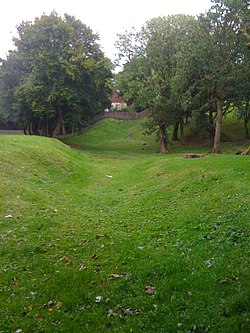| Watling Lodge | |
|---|---|
 | |
| Founded during the reign of | Antoninus Pius |
| Founded | 142 AD |
| Place in the Roman world | |
| Province | Britannia |
| Structure | |
| — Turf structure — | |
| Location | |
| Coordinates | 55°59′51″N3°49′31″W / 55.9976°N 3.8253°W |
| Town | Near Tamfourhill |
| County | Falkirk |
| Country | Scotland |
| Site notes | |
| Condition | Ruined |
Watling Lodge was a Roman fortlet on the Antonine Wall in Scotland. [1] It was located near what is now Lock Sixteen on the Forth and Clyde Canal in Falkirk with neighbouring forts at Rough Castle to the west and Falkirk to the east. [2] There was also a fort at Camelon to the north. There was also a Roman temporary camp found a short distance south of the site. [3]



